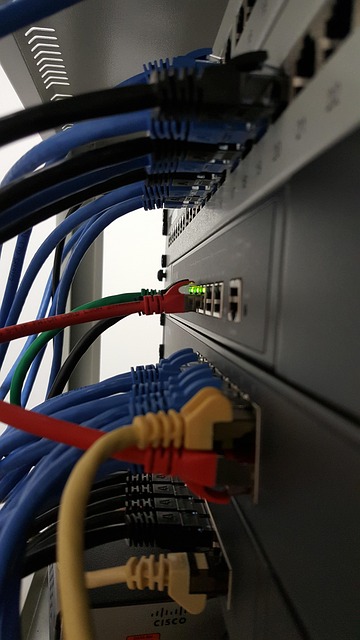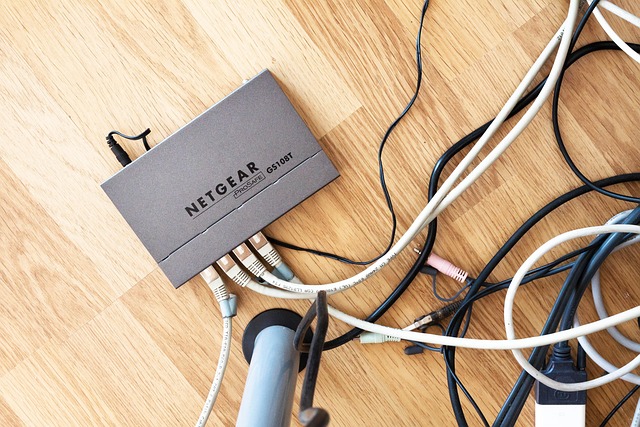Interpreting Network Cable Tester Results: A Complete Guide
Author: Jameson Richman Expert
Published On: 2025-11-05
Prepared by Jameson Richman and our team of experts with over a decade of experience in cryptocurrency and digital asset analysis. Learn more about us.
Network cable tester results tell you whether your Ethernet cabling is fit for purpose, where faults are located, and whether a run meets industry standards. This comprehensive guide explains common tester outputs, how to interpret LEDs and TDR traces, steps to diagnose faults, best practices to get reliable results, and how to document certification reports for handoff or warranty. Whether you’re using a basic continuity tester or a full certification tool, this article helps you turn raw results into actionable fixes.

Why network cable tester results matter
Accurate tester results are critical for network reliability, troubleshooting, and compliance. Poor cabling can cause intermittent outages, slow throughput, voice issues on VoIP, wireless performance degradation, and failed certification that voids contractor warranties. Reading and understanding tester outputs prevents unnecessary rework, speeds up troubleshooting, and ensures installations meet standards such as TIA/EIA-568 and IEEE 802.3.
For a quick reference on industry cabling standards, see the TIA-568 overview on Wikipedia’s TIA-568 page and the Ethernet standard summary at Wikipedia. These help explain why certain tests (like NEXT, return loss, and attenuation) are required for certified links.
Types of network cable testers and the typical results they produce
- Basic continuity/pinmap testers — show pair continuity, opens, shorts, miswires, and pair reversals (pass/fail and pin mapping).
- Advanced digital testers — in addition to continuity, display cable length (TDR), distance to fault, and sometimes simple PoE detection.
- Certification (level III) testers — provide full channel testing (NEXT, FEXT, return loss, insertion loss/attenuation), cable certification to Cat5e/Cat6/Cat6A limits, and PDF report generation.
Common network cable tester results and what they mean
1. PASS / FAIL
What it shows: The tester compares measured values to the selected standard (e.g., Cat5e, Cat6, ISO/IEC) and returns PASS or FAIL.
Interpretation: PASS indicates the link meets the standard requirements for parameters selected (length, attenuation, NEXT, etc.). FAIL means one or more parameters exceeded allowable limits. Always view detailed parameter readouts on a FAIL to locate the cause.
Action: For FAIL, inspect specific metrics (attenuation, NEXT) and pair mapping to determine whether the issue is connector termination, cable length, electromagnetic interference (EMI), or cable quality.
2. Open (No Continuity)
What it shows: One or more conductors have no electrical continuity from one end to the other.
Common causes: Bad crimp/termination, broken conductor, poor punch-down, or cable damaged by a staple/step.
Action: Verify termination at both ends, re-terminate if needed, or replace the cable. Use the tester’s TDR (time-domain reflectometer) distance-to-fault to locate the open if the cable is long.
3. Short
What it shows: Two or more conductors are shorted together (low resistance between them).
Common causes: Metal burrs, water ingress, crushed cable, or poor connector assembly.
Action: Inspect terminations for stray wire strands, replace RJ45 plug or patch panel jack, and check for environmental damage. If PoE is present, power down before opening connectors.
4. Miswire / Crossed Pair / Split Pair
What it shows: Pairs are not terminated to the correct pins — for example pin 1 connected to pin 3 at the far end.
Common causes: Incorrect punch-down pattern, poor modular jack wiring, or mixing T568A/T568B standards incorrectly across the site.
Action: Re-terminate using consistent standard (T568B is commonly used). For split pairs (where the pairs are mixed but pins appear connected), re-pair conductors to maintain pair integrity to avoid performance issues like increased NEXT.
5. Reversed Pair
What it shows: Both wires of a pair are connected but swapped — e.g., tip and ring reversed.
Impact: Ethernet often tolerates simple polarity reversals, but voice and some serial devices may fail. For PoE and Gigabit Ethernet, polarity reversal typically is tolerated because the physical layer can handle it; but best practice is to correct it.
6. Length & Distance to Fault (TDR)
What it shows: Cable length and the distance to opens or shorts when using TDR.
How to use it: If a cable shows an open at 37 meters, the TDR distance lets you locate the damaged area in the ceiling or wall. TDR readings are approximate and assume proper propagation velocity — adjust for cable type (e.g., Cat6 vs Cat5e).
7. High Attenuation (Insertion Loss)
What it shows: Signal loss measured in dB across frequency range; higher loss reduces maximum supported bandwidth and distance.
Causes: Excessive length, poor termination, low-quality cable, or high temperatures. Attenuation increases with frequency — becomes critical for 10G or PoE++.
Action: Shorten the run, re-terminate with proper connectors, or upgrade to higher category cable (e.g., Cat6A) if needed.
8. NEXT, FEXT, and Return Loss
What they show: Near-end crosstalk (NEXT) and far-end crosstalk (FEXT) measure interference between pairs; return loss measures reflected energy from impedance mismatches.
Interpretation: Poor NEXT or return loss indicates poor pair twisting consistency, bad terminations, or cable installed near EMI sources (electric motors, fluorescent lights). Certification testers provide frequency plots to diagnose frequency-dependent problems.
9. PoE Detection
What it shows: Whether Power over Ethernet is present and the class/voltage available.
Action: Verify PoE source before connecting sensitive devices. Some testers can safely detect PoE without powering devices; others require safe mode to avoid shorting power supplies.

How to read numeric and graphical outputs from testers
Different testers present results differently:
- LED pin maps: Simple testers show LED sequences to indicate which pin is connected to which remote LED. LEDs that do not light indicate opens; simultaneous LEDs indicate shorts.
- Numeric displays: Provide pair-by-pair resistance in ohms, length in meters/feet, and pass/fail metrics for each parameter.
- TDR traces: Show time vs. reflection magnitude. A sharp spike indicates a connector, while a rising reflection typically indicates an open. Distance markers let you find the location of the anomaly.
- Certification graphs: Frequency vs. NEXT/attenuation plots with PASS/FAIL envelopes overlayed. Look for lines crossing the limit — that frequency range or cable length may be non-compliant.
Example interpretation (textual):
- Result: PASS Cat6 — NEXT: 54 dB @ 1 MHz to 250 MHz; Attenuation: 10 dB @ 250 MHz; Length: 45 m. Interpretation: Link meets Cat6 limits and will support Gigabit Ethernet with margin.
- Result: FAIL Cat6 — Attenuation exceeded at high frequency (link crosses limit at 250 MHz). Interpretation: Likely issue with termination quality or marginal cable quality for high-frequency operation.
- Result: Open at 15.2 m (TDR). Interpretation: A broken conductor in the wall near the midpoint; re-run or re-terminate at accessible access point.
Step-by-step: Diagnosing problems using tester results
- Confirm the tester and settings: Ensure the tester is set to the correct standard (Cat5e/Cat6), and that the remote identifier is matched to the correct port.
- Check for basic continuity and pair map: Identify opens, shorts, and miswires. Correct these first; many higher-level failures stem from simple wiring errors.
- Measure length and distance-to-fault: If open/short exists, use TDR to find approximate distance and inspect that physical area.
- Run attenuation and NEXT tests (if available): Note which frequencies fail. High-frequency failures point to bad connectors, untwisted pairs, or poor cable category selection.
- Inspect terminations and physical path: Unload the jacket at both ends, confirm correct pair twist at the termination point (minimize untwisting), and replace suspect jacks or patch cords.
- Retest after repair: Always retest after each correction to ensure the root cause is fixed and that changes didn’t introduce new issues.
- Create a certification report if required: Use a certifier to generate PDF reports for project acceptance or warranty.
Best practices to ensure accurate network cable tester results
- Use the correct reference standard: Testing to Cat5e for a Cat6A run will give meaningless results. Match the tester standard to cabling and expectations.
- Verify tester calibration: Certification testers require periodic calibration — follow manufacturer schedule to ensure accuracy.
- Minimize untwisting at terminations: Keep pair untwist length to a minimum (typically less than 13 mm / 0.5 in at the jack) to reduce NEXT and return loss issues.
- Use proper tools and connectors: Quality jacks, plugs, and patch panels and correct punch-down techniques impact results significantly.
- Isolate from EMI: Maintain distance from electrical interference sources and avoid parallel runs near power cabling where possible.
- Test both channel and permanent link: Channel includes patch cords; permanent link excludes them. Understand which you need to certify per contract.
- Power down PoE where necessary: If you need to open connectors or use a basic multimeter, disable PoE to avoid damage and incorrect readings.

When to use a certification tester vs a basic tester
Choose your tool based on the job:
- Basic installations and small troubleshooting: A continuity/pinmap tester or inexpensive digital tester is sufficient to find opens, shorts, and miswires.
- Commercial installations or warranty/certification required: Use a Level III certification tester (e.g., Fluke CertiFiber®/LinkRunner or similar) to measure attenuation, NEXT, return loss, and create PDF reports for acceptance.
- High-performance networks (10G and above): Certification to Cat6A (or better) with advanced tests is essential to guarantee performance.
Documenting and storing cable tester results for audits and warranty
Proper documentation reduces callbacks and proves compliance:
- Always save tester reports as PDFs with site name, job ID, tester serial number, date, and operator name.
- Label each run with unique IDs and include them in the report so run results can be traced to physical cables.
- Store results in a centralized repository (cloud or on-site server) with backups—this helps with future troubleshooting and proof for contractors’ warranties.
- For large deployments, consider database-driven cable management systems that store tester results linked to port and patch panel location.
Real-world examples and case studies
Case 1 — Intermittent VoIP dropouts
Symptoms: Random voice dropouts on several phones in a single wing.
Tester results: Intermittent NEXT spikes on multiple runs when tested under load; patch cords showed periodic high resistance.
Diagnosis & fix: Loose patch panel terminations and aging patch cords caused reflections under certain loads. Solution was re-terminating patch panel RJ45s and replacing patch cords. Post-repair certification showed clean NEXT and voicemail issues stopped.
Case 2 — Network link fails at 1 Gbps but works at 100 Mbps
Symptoms: Switch ports negotiates 100 Mbps only though adapters support 1 Gbps.
Tester results: High attenuation at higher frequencies and split pairs discovered on the run.
Diagnosis & fix: Teleworker had used a low-quality patch cord and incorrectly paired terminations at the wall jack — re-terminating to maintain pair twist and replacing patch cords resolved the issue and restored 1 Gbps support.

Recommended tools and features to look for in a cable tester
- Pair mapping and LED remote IDs — for quick mapping of long runs.
- TDR/distance-to-fault — essential for locating opens and shorts inside walls.
- Attenuation/Insertion loss and NEXT measurement — required for certification to Cat5e/Cat6/Cat6A.
- PoE detection and load testing — to safely detect and validate PoE sources.
- Report generation and storage — PDF export and naming fields for documentation.
- Calibration and self-test capability — ensures long-term accuracy.
Brands often used by professionals include Fluke Networks, Ideal Networks, and Klein Tools. Fluke is widely referenced for certification-level gear; for education on certification testing methodology, see manufacturer documentation and standards references.
Checklist: Interpreting and acting on network cable tester results
- Identify PASS or FAIL and record which parameter(s) failed.
- For opens/shorts, use TDR to find distance and inspect the physical run.
- For NEXT/return loss failures, review terminations for untwisted pairs and replace low-quality patch cords.
- Always retest after repairs and save the report with cable identifiers.
- Follow the appropriate standard (TIA/EIA-568, ISO/IEC) for acceptance and warranty compliance.
Further reading and authoritative resources
Standards and protocol overviews help you understand why testers measure specific parameters:
- TIA/EIA-568 cabling standard (Wikipedia) — overview of cable categories and termination requirements.
- Ethernet (IEEE 802.3) overview — background on physical layer requirements.
- Federal Communications Commission (FCC) — information about communications regulation (useful for legal/regulatory context in some projects).

Related tools and resources (bonus)
If you are also involved with network monitoring or trading-oriented workflows that require alerting or real-time data (unrelated to cable testing but helpful for infrastructure teams managing monitoring stacks), you may find the following resources useful:
- TradingView alert rate limit 2025 guide — guide on managing alert limits in TradingView.
- Bitcoin live price and trading insights — real-time market insight resource.
- Complete crypto trading guide PDF for 2025 — downloadable trading resource.
- Mexico trade goods partners and trends — economic background that may matter for procurement planning.
If you manage infrastructure and also use crypto or trading platforms for corporate funds or automated alerting, here are some registration links you might find relevant (use with caution and ensure compliance with internal policies):
Final tips to get reliable network cable tester results every time
- Always start with a clean, consistent termination process — most problems start at the connector.
- Use the right tool for the job: invest in certification gear for business-critical installs; basic testers are fine for quick field checks.
- Keep detailed, labeled reports for every run — future troubleshooting is much faster when you have baseline data.
- Train technicians on interpreting TDR traces and certification plots — understanding the graphs avoids guesswork.
- Maintain tools and follow calibration schedules — accurate measurements depend on accurate instruments.
Understanding and acting on network cable tester results prevents downtime, ensures performance, and protects warranties. With the right tools, consistent test methodology, and good documentation practice, you'll reduce troubleshooting time and deliver cabling that reliably supports modern networks.